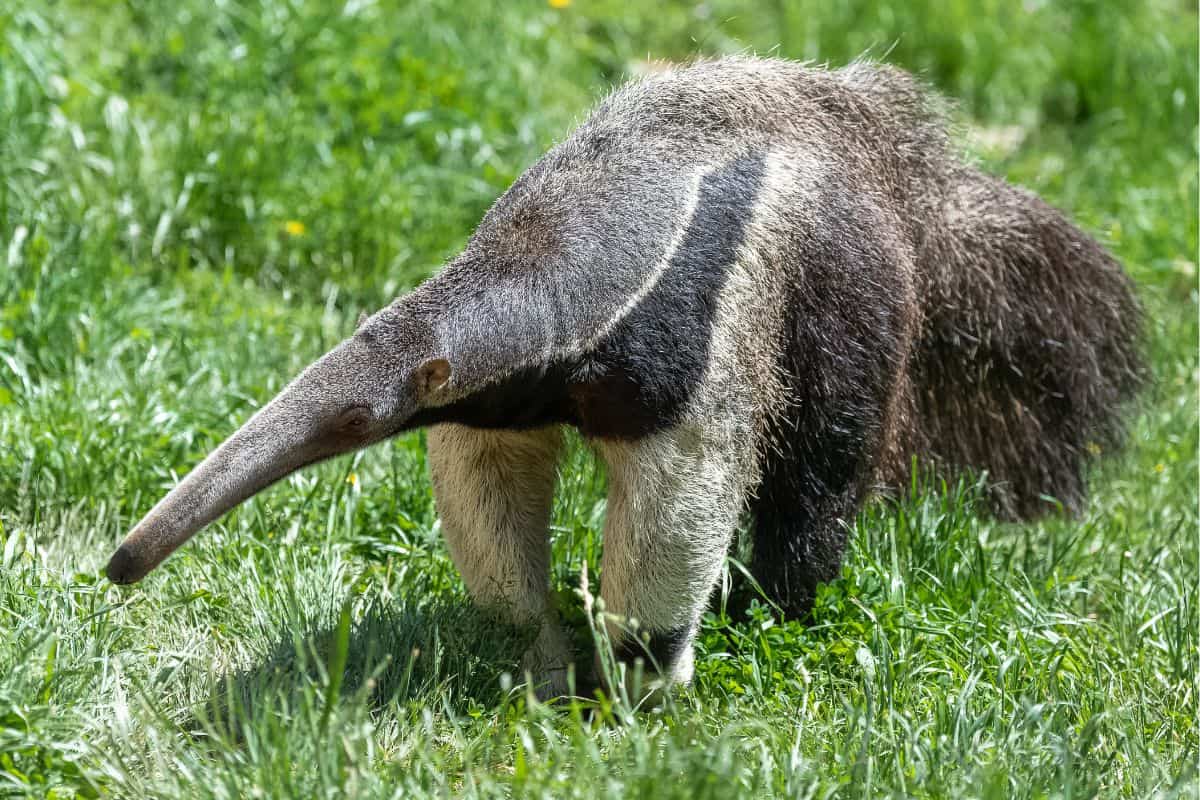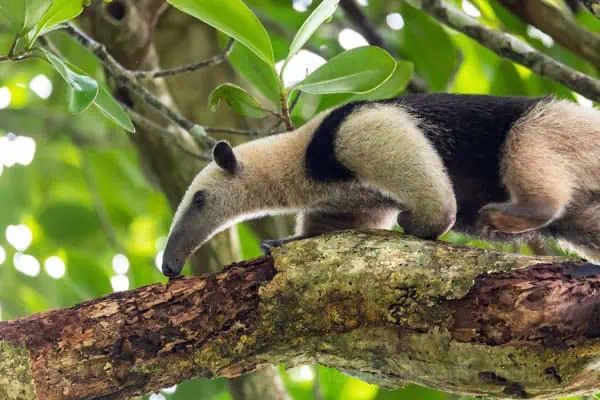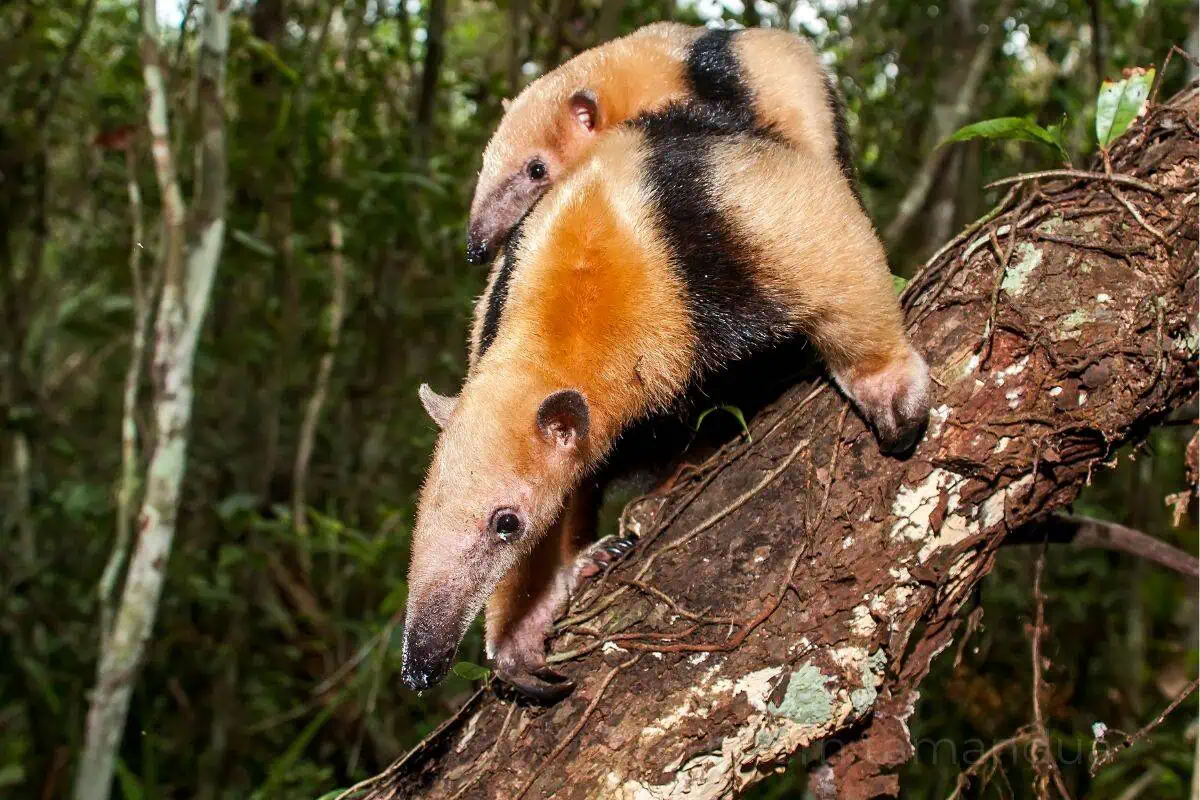Anteaters are a small but fascinating group of mammals built to devour ants and termites. There are only four true types of anteaters, each with a long snout, sticky tongue, and strong claws made for ripping into nests. Found across Central and South America, they range from the massive, ground-dwelling giant anteater to the tiny, tree-dwelling silky anteater. This article covers all four species, where they live, and the unique features that set them apart.
Types of anteaters
1. Giant anteater

Scientific name: Myrmecophaga tridactyla
Location: Central and South America, from Honduras and Nicaragua through much of South America, especially in savannas and grasslands of Brazil, Paraguay, and Argentina
The giant anteater is the largest of the group, often reaching seven feet long when you include its sweeping tail. It walks on its knuckles to protect long, curved claws used to break into termite mounds and ant nests. With a tubular snout and a tongue that can flick in and out rapidly, it slurps up thousands of insects in short feeding bouts and moves on before soldier ants can swarm.
Giant anteaters are mostly solitary and ground dwelling. They rely heavily on smell to find food and to navigate, since their eyesight is limited. In the wild they spend much of the day traveling between feeding sites, resting in tall grass, and using their tail as a blanket for camouflage and warmth.
2. Northern tamandua
Scientific name: Tamandua mexicana
Location: Southern Mexico through Central America into northern South America, including Colombia and Venezuela
The northern tamandua is a medium sized anteater that splits its time between the ground and the trees. A strong prehensile tail works like a fifth limb, helping it balance and climb as it searches for arboreal ant and termite nests. Many individuals have a pale coat with a striking black vest pattern along the shoulders and sides.
This species adapts to many habitats, from wet forest edges to second growth and plantations. Activity can be daytime or nighttime depending on local conditions. Diets center on ants and termites, yet they will also raid bee nests for honey and larvae when available.
3. Southern tamandua
Scientific name: Tamandua tetradactyla
Location: Much of tropical and subtropical South America, east of the Andes from Venezuela and the Guianas down through Brazil, Bolivia, Paraguay, and northern Argentina
Similar in size to its northern cousin, the southern tamandua varies widely in color, from sandy gold to darker coats with or without a vest pattern. It climbs well, using a muscular tail and strong forelimbs to access nests in trees, but it also forages on the ground where ant traffic is heavy.
Southern tamanduas thrive in a range of settings, including gallery forests, savannas, and forest edges. Sharp foreclaws tear into decaying logs and termite galleries. When threatened, they often rear up against a trunk, brace with the tail, and swipe with powerful forelimbs to keep predators at bay.
4. Silky anteater
Scientific name: Cyclopes didactylus
Location: Patchy distribution from southern Mexico through Central America into northern South America, especially in humid forests near rivers
The silky anteater is the smallest and most elusive member of the group, typically weighing less than a pound. Its dense, soft fur ranges from silvery to golden, which helps it blend into clusters of seed pods and leaves where it rests during the day. The tail is prehensile, and the body is built for quiet, careful movement among branches.
Entirely arboreal and mostly nocturnal, silky anteaters specialize on small arboreal ant species. They move slowly to avoid detection, pausing often before probing with a slender snout and a sticky tongue. Because they spend so much time high in the canopy, sightings are rare.
Are pangolins anteaters?
No. Pangolins and anteaters look alike because of convergent evolution, not close kinship. Pangolins live in Africa and Asia, have keratin scales, and belong to a different lineage. True anteaters live in the Americas and lack scales, but both evolved long tongues and strong claws to exploit ant and termite prey.
How did anteaters adapt for eating ants?
All four species share specialized tools for insect hunting. Their skulls are elongated into a narrow snout, and the tongue is long, slender, and coated in sticky saliva to pick up many insects quickly.
They have no teeth, so food is crushed in the stomach with the help of tough tissues and swallowed grit. Forelimb claws are large and curved, perfect for opening hard termite mounds and ripping into rotting wood.
Where do anteaters live?
True anteaters are native to Central and South America. Giant anteaters favor open habitats like grasslands and savannas but also use forest edges. Tamanduas occur in forests, second growth, and mosaics with both trees and open areas. Silky anteaters are tied to humid forests, often near waterways, and spend nearly all their time in the canopy.
Are anteaters dangerous?
Anteaters are not aggressive, yet they will defend themselves if cornered. The forelimb claws can inflict serious wounds, especially on larger species like the giant anteater. Large predators will often avoid the giant anteater because of its deadly claws.
Give wild individuals plenty of space, avoid blocking escape routes, and observe from a respectful distance for both your safety and theirs.
WildlifeInformer.com is your #1 source for free information about all types of wildlife and exotic pets. We also share helpful tips and guides on a variety of topics related to animals and nature. Subscribe on YouTube for videos.



